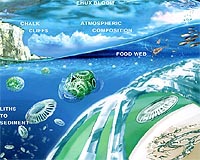| . |  |
. |
Southampton, UK (SPX) Mar 30, 2010 Some regions of the deep ocean floor support abundant populations of organisms, despite being overlain by water that contains very little oxygen, according to an international study led by scientists at the United Kingdom's National Oceanography Centre, Southampton. But global warming is likely to exacerbate oxygen depletion and thereby reduce biodiversity in these regions, they warn. The sunlit surface waters tend to be well oxygenated as a result of their connection with the atmosphere. Here, tiny marine algae called phytoplankton thrive. When they die and sink, they are degraded by bacteria, using oxygen from the water column. In regions of high plant growth, this can result in the natural development of mid-water oxygen minimum zones (OMZs), especially where oxygen is not replenished by mixing of the water column. Where they touch the continental slope, OMZs create strong seafloor oxygen gradients at depths between 100 and 1000 m. In addition to low oxygen, sediments within OMZs often contain large amounts of organic matter. As a result, species of animals and protozoans (foraminifera) that can tolerate low oxygen may flourish, despite the stressful conditions. However, if oxygen depletion is very severe, many types of animals disappear. Where animals are present, OMZs provide a variety of habitats created by steep gradients in oxygen and sulphide concentrations, different seafloor types, and variations in acidity and nutrient availability. In this new synthesis, based on a survey of published and unpublished data, the team of researchers analysed the habitats and biodiversity of well-developed OMZs in the Arabian Sea, eastern Pacific and Bay of Bengal. "Oxygen seems to be the overriding factor controlling biological diversity and seabed community composition within OMZ core regions," said Professor Andrew Gooday of NOCS: "Where oxygen levels increase, the strong seafloor gradients create variety that exerts an increasingly important influence, with different habitat types supporting different kinds of organisms. In particular, the lower boundaries of OMZs, where oxygen levels begin to rise and food is plentiful, often teem with large organisms, among them brittle stars and spider crabs." On some continental margins, exposed rocks support encrusting animals, while muddy regions with organic-rich sediments support tube-living organisms and bacterial mats. Movements of the upper boundaries of OMZs, caused by seasonal or longer-term climatic changes, may cause sudden shifts in community composition. The activities and bodies of some organisms also create opportunities for others. Even the dead play their role. "The skeletons and carcasses of marine animals provide discrete habitats where other creatures can thrive," said NOCS' Dr Brian Bett: "For example, scavengers such as shrimp-like crustaceans exploit accumulations of dead jellyfish, fish and crabs, while other species live off whale bones." Although the upper boundaries of OMZs can move up and down in response to climatic changes, the core regions of OMZs are typically very stable, persisting over geological timescales. "OMZs may be a cradle of biological diversity, promoting speciation by creating strong gradients in the environmental conditions that are important for species as well as barriers to population exchange," explained Gooday, while acknowledging that this needs to be fully investigated using molecular techniques. Although diversity is strongly depressed locally, particularly in OMZ cores, the researchers conclude that, on balance, OMZs probably enhance regional diversity because they tend to increase environmental variety. In addition, low oxygen concentrations promote adaptations, such as small body size and enlarged body surfaces, which enhance oxygen uptake. However, global climate change presents a major threat - "Increased ocean temperature is expected to reduce vertical water mixing and decrease oxygen solubility in seawater," said Bett: "If this results in larger, more intense OMZs, the impact on biodiversity is likely to be negative." The researchers are Andrew Gooday and Brian Bett (NOCS), Elva Escobar (Universidad Nacional Auto� noma de Mexico), Baban Ingole (National Institute of Oceanography, India) , Lisa Levin and Carlos Neira (Scripps Institution of Oceanography, La Jolla), Akkur Raman (Andhra University, India), and Javier Sellanes (Universidad Cato� lica del Norte, Coquimbo, Chile).
Share This Article With Planet Earth
Related Links National Oceanography Centre, Southampton Water News - Science, Technology and Politics
 Ecosystems Under Threat From Ocean Acidification
Ecosystems Under Threat From Ocean AcidificationEdinburgh, UK (SPX) Mar 29, 2010 Acidification of the oceans as a result of increasing levels of atmospheric carbon dioxide could have significant effects on marine ecosystems, according to Michael Maguire presenting at the Society for General Microbiology's spring meeting in Edinburgh this week. Postgraduate researcher Mr Maguire, together with colleagues at Newcastle University, performed experiments in which they simul ... read more |
|
| The content herein, unless otherwise known to be public domain, are Copyright 1995-2010 - SpaceDaily. AFP and UPI Wire Stories are copyright Agence France-Presse and United Press International. ESA Portal Reports are copyright European Space Agency. All NASA sourced material is public domain. Additional copyrights may apply in whole or part to other bona fide parties. Advertising does not imply endorsement,agreement or approval of any opinions, statements or information provided by SpaceDaily on any Web page published or hosted by SpaceDaily. Privacy Statement |